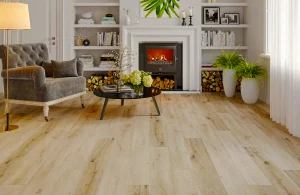
Linoleum is a convenient, eco-friendly flooring material that is relatively easy to clean and maintain and will save you a lot of time and effort. However, cleaning linoleum can be tricky. Since it is made of natural ingredients such as cork, linseed oil, and wood dust, harsh chemicals and cleaning products with strong ingredients should not be used on linoleum.
Yes, linoleum is durable and low-maintenance, however, it isn’t as tough as vinyl for example. This is why extra care needs to be taken when treating this flooring material in order to prevent damage from happening, as well as prolong the flooring’s lifespan.
This article will show you how to properly clean your linoleum floors, what to use, and how to take care of it in order to enjoy it for many years.
How often should you clean your linoleum floor?
How often should you clean and maintain your linoleum floors? This will be determined by how heavily your floor is used, as well as a number of other things. Are muck and grime being tracked onto the floor on a regular basis? Are foods and liquids routinely spilled? Is it a recent linoleum with a strong wear layer, or an older floor easily scraped by dirt and grit?
Cleaning a linoleum floor weekly is generally a good idea, but depending on the circumstances, you may need to do it every day or no more than once a month.
The best indicator is to carefully inspect the floor on a daily basis. If dirt and stains are visible, clean the floor, even if it has been cleaned recently.
Daily linoleum cleaning – In order to maintain your linoleum flooring clean for longer, prevent damage and make its thorough cleaning easier, you should give it a quick wiping down on a daily basis or between deep cleans (if you deep clean the linoleum once every month for example). You can clean and maintain your linoleum floor on a daily or weekly basis in between deep cleans. Use the following quick tips:
- To remove dirt that has become ground into the floor, dust mop (with a dry microfiber mop) every day or every few days.
- When vacuuming your linoleum floor on a daily or weekly basis, remove the beater brush and utilise the hard floor setting.
- Damp mop the floor once a week using a mix of water and liquid dish soap, then rinse with clean water and dry completely with a soft towel or air-dry.
- Restore shine as needed with a quick damp mop and a bucket of water with a cup of white vinegar (no need to rinse unless you prefer to do so). Thoroughly dry the floor.
Deep cleaning linoleum flooring
- Always sweep and dust the floor first. Make sure you remove all solids, large particles, and debris. Make sure there is no mud or dust left behind since when the mopping time comes, you will only end up smearing this mess around causing more dirt to occur on your floor. Pay extra attention to corners and areas that are hidden or hard to reach.
- Wiping down the entire floor with a microfiber cloth is a good option since it removes any lingering microscopic particles of grit that could potentially scrape the floor during deep mopping.
- Prepare your cleaning solution. We suggest you avoid using any harsh chemicals and strong cleaning solutions. Instead, fill a gallon of hot water in a bucket, then add 6 to 8 drops of regular, over-the-counter dish soap. Anything very harsh or acidic should be avoided. Use the same soap that you use on your dishes. This solution should then be gently stirred.
- Dip your mop into the soapy bucket and completely wring it out. Linoleum can be damaged by standing water, so clean the floor with as little liquid as possible. The mop’s strands should be just moist and soapy.
- Divide the room into sections. As you finish each phase, return the mop to the bucket, wring it dry, and begin over in the next section. Repeat until the entire floor is covered. When you’re through, empty the bucket of soapy water and wash it, as well as the mop, in clean water.
- Toss out the dirty water and fill the bucket with clean warm water. Now is the perfect time to rinse your mop as well. Mop the whole floor using plain water. Make sure you get rid of all soapy residue that may still be on it since it will end up attracting more dirt and grime in the future.
- After the floor has been thoroughly cleaned, you must remove any remaining wetness. Standing water can be extremely hazardous to the installation of linoleum flooring. To accomplish this, use old rags or towels to dry the floor’s surface.
If there are any stubborn stains that would not come out that easily, you can use the methods we mentioned above with a scrub brush. You can also sprinkle baking soda on pet stains or other stinky areas of your linoleum. Make sure you don’t let dirt and grime sit on it for too long since they may become permanent.
